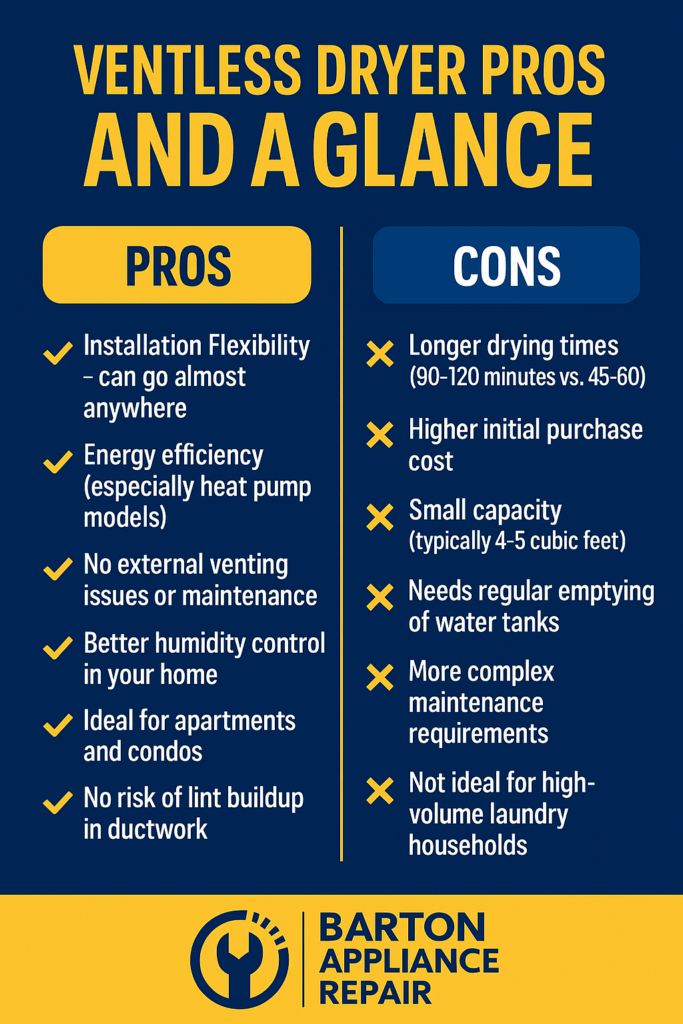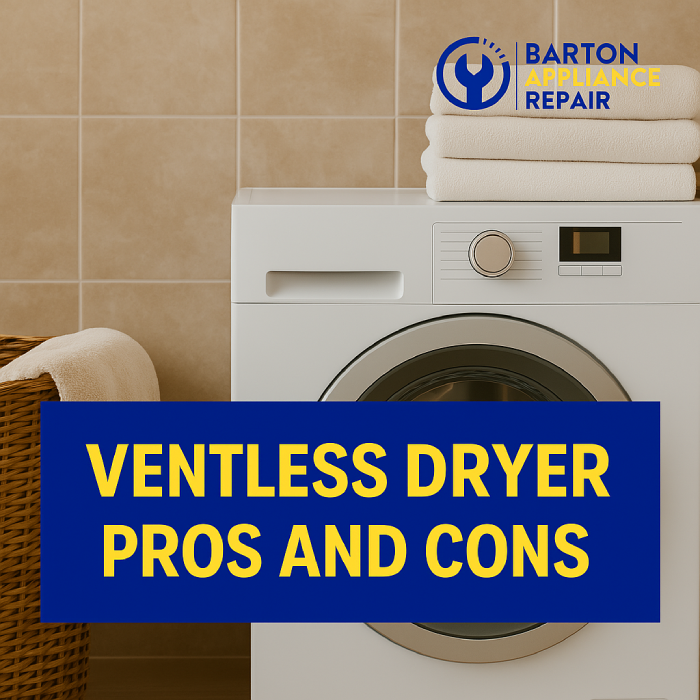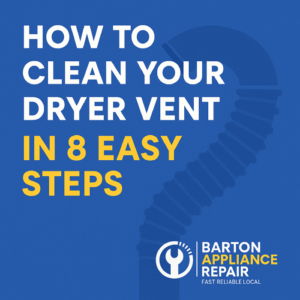Shopping for a new dryer can quickly end up overwhelming you with all the different options. If you’re living in an apartment, condo, or a small home where venting is not exactly possible, then ventless dryers are a good solution. But are they the right choice for you?
These machines are different from traditional vented dryers that release hot, humid air outside through ducts. These dryers use alternative technologies to remove moisture from your clothes without needing external venting. This difference has its advantages and disadvantages that every buyer should know.
This guide will tell you everything you need to know about ventless dryers, from how they work to their impact on your bills. We’ll take a look at the benefits and then the drawbacks to help you decide if a ventless dryer makes sense for your living situation, laundry habits, and budget.
What Are Ventless Dryers?
They are laundry appliances designed to dry clothes without expelling air outside through a vent or duct. They come in two main types: condenser dryers and heat pump dryers. Each of them uses different technology to remove moisture from wet clothes.
Condenser Dryers
These work by using heated air to remove moisture from clothes. Instead of venting this humid air outside like traditional dryers, they pass air through a heat exchanger where the moisture turns into water. This, then, either collects in a removable tank that needs to be regularly emptied or drains directly through a hose.
The cooled, dehumidified air heats us again and then recirculates to continue the drying process. This closed-loop system removes the need for external venting.
Heat Pump Dryers
These are the newer, more energy-efficient technologies in this category. These use a refrigeration system that is the same as air conditioners to remove moisture. The dryer pulls in the air, heats, and circulates it through the drum to absorb moisture from the clothes.
The warm, humid air then passes through an evaporator, cools it down and then condenses the moisture. A compressor and condenser reheat the air before it returns to the drum. This process uses a lot less electricity than traditional or condenser dryers because it recycles heat rather than generating new heat continuously.
Pros and Cons at a Glance

Pros |
Cons |
| Installation Flexibility – can go almost anywhere | Longer drying times (90-120 minutes vs. 45-60) |
| Energy efficiency (especially heat pump models) | Higher initial purchase cost |
| No external venting issues or maintenance | Small capacity (typically 4-5 cubic feet) |
| Gentler on clothes due to lower temperatures | Needs regular emptying of water tanks |
| Better humidity control in your home | More complex maintenance requirements |
| Ideal for apartments and condos | Not ideal for high-volume laundry households |
| No risk of lint buildup in ductwork | May release minimal heat into the room |
Pros of Ventless Dryers
Installation Flexibility
Perhaps the biggest advantage of ventless dryers is their installation flexibility. Without the need for external venting, these appliances can be placed anywhere with access to electricity. This makes them perfect for:
- Apartments and condos with restrictions on exterior modifications
- Interior rooms without exterior walls
- Historic homes where adding ductwork would be a lot of difficulty
- Closets, kitchens, bathrooms, or other small spaces where traditional dryers wouldn’t work
The ability to install ventless dryers in different locations opens up possibilities for creating efficient laundry spaces in homes where traditional dryers simply are not an option.
Energy Efficiency
Heat pump dryers, in particular, give impressive energy savings as compared to normal vented models. Meanwhile, condenser dryers roughly use the same amount of electricity as vented dryers. It’s just that heat pump models can reduce energy consumption by up to 50%.
The energy efficiency comes from their ability to recycle heat within the closed system rather than continuously generating new heat. This technology has earned many heat pump dryers ENERGY STAR certification, which qualifies them for utility rebates in some areas.
Over time, these energy savings can come at the higher cost of heat pump models, especially in homes that have a lot of laundry loads.
No Exterior Venting Issues
Traditional dryers need vents that can become clogged with lint, reducing efficiency and even creating fire hazards. These vents can also create openings in your home’s exterior that can:
- Allow cold air to enter during the winter months
- Become entry points for pests
- Need regular cleaning and maintenance
- Reduce over time, needing replacement
Ventless dryers reduce these concerns entirely. Without exterior venting, there’s no risk of lint buildup in ductwork, no need for regular vent cleaning, and no possible entry points for drafts or pests.
Gentler on Clothes
The reduced working temperatures of most ventless dryers, particularly heat pump types, are more fabric-friendly. Older dryers usually operate at high temperatures, which will damage your clothes over time.
Heat pump dryers work at 20-30F which is lower than normal dryers. This increases the life of your clothes. Delicate clothing is advantaged by this milder drying process.
Better Humidity Control
In humid climates, vented dryers can actually pull the additional moisture from outside into your home through the negative pressure they create. Ventless models avoid this issue completely, because they work as a closed system.
Some ventless dryers even allow you to direct the minimal heat they produce into your living space during the winter months. They also exhaust it outside during summer, giving you more control over your home’s internal environment.
Related: Dishwasher Brands to Avoid: A Practical Guide
Cons of Ventless Dryers
Longer Drying Times
The most common complaint about these dryers is the long cycles. A vented dryer can complete a load in 45-60 minutes, these usually need 90-120 minutes or sometimes even longer.
Heat pump dryers generally take the longest to dry clothes because of their low working temperature. This increases drying time, which can be a problem for homes that have multiple rounds of laundry.
The longer cycles are from the technology used to remove moisture without venting. The process of condensing moisture and recirculating air simply takes more time than the direct heat and vent approach of traditional dryers.
Higher Initial Cost
Ventless dryers come with a premium price tag compared to their vented counterparts. The latter ones start at around $400, while ventless models usually start at $700-$900 for condenser units and $1,000-$1,800 for heat pumps.
This price difference reflects the more complex technology involved in ventless systems. For budget-conscious shoppers, this higher upfront cost can be a big thing, even though operating costs may be lower over time, especially with heat pump models.
Smaller Capacity
Most ventless dryers have smaller drums. While full-sized vented models can easily fit in 7-9 cubic feet of laundry, ventless ones usually take 4-5.
It means you will need to do more loads for the same amount of laundry. For bigger households that have a lot of washing, less capacity with longer drying times can impact laundry day.
Maintenance Requirements
Ventless dryers don’t need vent maintenance, but there are other needs that you need to take care of:
- Condenser dryers have water collection that needs to be emptied after every 1-2 loads.
- Condensers also need regular cleaning to maintain efficiency.
- Heat pump parts need occasional maintenance to make sure they are working perfectly.
- Lint traps need more cleaning than in normal vented dryers.
Some models have a direct drain option that eliminates the need to empty water tanks manually. But these need closeness to a drain and proper installation.
Environmental Considerations
Though ventless dryers, especially heat pump ones, use less energy when working, they have more complex parts and refrigerants than traditional dryers. This complexity makes them more difficult to recycle at the end of their life.
The refrigerants used in heat pump dryers are better than earlier ones. Although they still have some global warming potential if they are not properly recovered during disposal. Environmentally conscious consumers should make sure that these appliances go through certified recycling programs.
Related: What’s the Best Dishwasher You Can Buy in Canada?
Practical Considerations Before Buying
Space Assessment
Before buying a ventless dryer, measure your available space carefully. Though these machines don’t need venting, they do need:
- A few inches of clearance on all sides for proper air circulation.
- Access to a power outlet (usually 220V for full-sized models).
- For convenience, closeness to a drain for direct water disposal.
- Enough room for door opening (some models have reversible doors).
Most ventless dryers are made to be compatible with standard 24-inch or 27-inch washing machines, making them suitable for stacking in compact laundry areas.
Laundry Volume and Habits
Think about your laundry patterns when evaluating ventless dryers:
- Households doing multiple loads daily will find long drying times frustrating.
- Those who mainly do laundry overnight or during work hours might not be bothered by the same.
- Families with large items, with comforters, may struggle with the smaller capacity.
Some users easily adapt to these limitations with new laundry routines like running loads overnight or investing in drying racks for partial air-drying to reduce machine drying time.
Cost Analysis
To know if a ventless dryer makes financial sense for your situation, consider:
- Initial purchase price versus conventional models
- Installation savings (no vent installation needed)
- Possible energy savings over time (especially with heat pump models)
- Potential utility rebates for energy-efficient models
- Expected lifespan (usually 10-13 years, similar to vented models)
For apartments or temporary living situations, the higher upfront cost may not be justified. But, for homeowners who plan on staying in one place for many years, the long-term savings will be helpful.
Climate Considerations
Your local climate affects ventless dryer performance:
- In humid environments, drying times take a lot of time.
- In very dry climates, the small amount of humidity released into the room could actually be good.
- When it’s cold, the heat output is less, which can help in your home heating.
Vented dryers can create negative pressure and actually pull cold air into your home during winter. Meanwhile, ventless models have a neutral impact on your home’s air pressure.
Related: The Top 5 Smart Appliances Every Modern Household Needs
Who Should Consider a Ventless Dryer?
These dryers are well-suited for:
- Apartment or condo dwellers with venting restrictions
- Homeowners with limited space who need flexible installation options
- People looking to create laundry facilities in unconventional spaces
- Energy-conscious consumers (especially for heat pump models)
- Those who prioritize gentle clothes drying
- Households that can adjust to longer drying times
These appliances provide a practical solution for situations where normal dryers are not a great option. These give you independence from laundromats without needing major home changes.
Who Should Stick With Traditional Vented Dryers?
Normal dryers are a better choice for:
- Large households with a lot of laundry needs
- Budget-conscious shoppers who prioritize low upfront cost
- Homes that already have proper venting
- Those who need the fastest drying times
- People who dry large items like blankets or comforters
If your home already has an external venting and you don’t have any major reason to choose a ventless model, then a normal dryer is better for you.
Related: How Much Does It Cost to Fix a Washing Machine?
Conclusion
Ventless dryers are a good innovative solution for drying clothes in situations where traditional vented models are not practical. They have installation flexibility, energy savings, and gentler fabric care. This makes them appropriate for a lot of people.
But their longer drying times, higher initial cost and smaller capacity have trade-offs. Knowing the pros and cons is important before you decide according to your needs.
Before making your final decision, think about visiting an appliance showroom to see ventless models in person. Many retailers have floor models you can check to better understand their features, capacity, and control systems. This will help you select a dryer that meets your needs.
For more such information, contact Barton Appliance Repair today!





